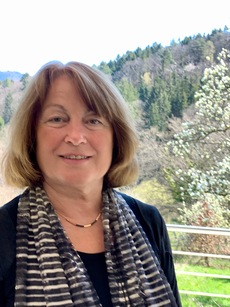
Prof. Dr. Andrea Hartwig
- Room: 103
- Phone: +49 721 608 47645
- Fax: +49 721 608 47255
- andrea hartwig ∂does-not-exist.kit edu
- lmctox.iab.kit.edu
Karlsruher Institut für Technologie (KIT)
Institut für Angewandte Biowissenschaften
Abteilung für Lebensmittelchemie und Toxikologie
Gebäude 50.41 (AVG)
Adenauerring 20a
76131 KarlsruheSekretariat Sonya Schlander
+49721 608 42133
Academic Training
1996 Habilitation
University of Bremen, Biochemistry
1987 Ph.D.
University of Bremen, topic: "Mutagenicity and comugenicity of nickel and chromium compounds"
1977 - 1984 Study of Chemistry
University of Bremen
Scientific Career
since 2010 Full Professor (Food Chemistry and Toxicology), Karlsruhe Institute of Technology (KIT)
2004 - 2010 Full Professor (Food Chemistry), Technical University Berlin
1998 - 2004 University Professor (Food Chemistry), University of Karlsruhe
1996 - 1998 Associate Professor, University of Bremen
1988 - 1998 Scientific Assistant, University of Bremen
1986 Research stay at the "Institute of Environmental Medicine",
Sterling Forest, New York, in the laboratory of Prof. Rossman
Main Research Areas
Impact of carcinogenic metal compounds, metal-based nanoparticles, essential trace elements and bioactive food ingredients on the stability of the genome, in particular:
- Oxidative stress
- Induction and repair of DNA damage
- Interactions with the cellular response to DNA damage (DNA repair systems, cell cycle control and tumor suppressor functions)
- Interactions between toxic and essential metal ions
- Impact on gene expression profiles
- Epigenetic changes
- Interactions with the redox regulation of cellular signaling pathways
Offers, Honours, Awards and Special Recognitions (selection)
2021 Nomination as Member (representative of KIT) of the EU “High Level Roundtable on the Chemicals Strategy for Sustainability”
2018 Toxicology Award of the Society of Toxicology (GT)
2009 Offer of a Full Professorship „Food Chemistry and Toxicology“ at Karlsruhe Institute of Technology (KIT) (accepted)
02/2009 Offer of a Full Professorship "Nutritional Toxicology" at the University of Potsdam (declined)
2008 Innovation Award 2008 of the "Deutsche Gesellschaft für Arbeits- und Umweltmedizin e.V." (DGAUM),
for the development of concepts for occupational exposure limit settings
2007 Nomination as Chair of the "Permanent Senate Commission for the Investigation of Health
Hazards of Chemical Compounds in the Work Area" (MAK-Commission)
2006 Award of the "Gesellschaft für Umwelt-Mutationsforschung" (GUM)
2004 Offer of a Full Professorship "Food Chemistry" at the Technical University of Berlin (accepted)
1998 Offer of a Professorship "Food Chemistry" at the University of Karlsruhe (accepted)
Membership in Scientific Committees
- Since 2021: Member (representative of KIT) of the EU “High Level Roundtable on the Chemicals Strategy for Sustainability”
- Co-opted member in the Risk Assessment Committee (RAC) of the European Chemicals Agency (ECHA), since 2018
- Chair of the "Permanent Senate Commission for the Investigation of Health Hazards of Chemical Compounds in the Work Area" (MAK-Commission), since 2007, mandate currently prolonged until 2023
- Member of the German “Committee of Hazardous Substances” since 2007
- Member of the Central Committee on Biological Safety (ZKBS) in Germany, 2018 - 2021
- Member of the "Scientific Committee on Occupational Exposure Limits" (SCOEL), 2007 - 2019
- Chair of the German Society for DNA Repair (DGDR), 2010 - 2014
- Member of the “Human biomonitoring commission“ of the Federal Office for Environment, Germany, 2010 - 2013
- Member of the Scientific Advisory Board of the Federal Institute for Risk Assessment (BfR), Germany, 2007 - 2012
- Expert for the European Food Safety Authority (EFSA), 2010, 2011
- Member of several working groups of the "International Agency for Research on Cancer" (IARC), since 2004
Publications
More than 200 publications, among them more than 160 in high-ranking, peer-reviewed toxicological journals; h factor (Scopus): 57
Selected Publications
-
Schumacher P., Fischer F., Sann J., Walter D., Hartwig A. (2022) Impact of nano- and micro-sized chromium(III) particles on cytotoxicity and gene expression profiles related to genomic stability in human keratinocytes and alveolar epithelial cells. Nanomaterials, 12: 1294.
-
Wedler N., Matthäus T., Strauch B., Dilger E., Waterstraat M., Mangerich A., Hartwig A. (2021) Impact of the cellular zinc status on PARP-1 activity and genomic stability in HeLa S3 Cells. Chem Res Tox, 34, 839-848.
-
Hartwig A., Arand M., Epe B., Guth S., Jahnke G., Lampen A., Martus HJ., Monien B. M., Rietjens I., Schmitz-Spanke S., Schriever-Schwemmer G., Steinberg P., Eisenbrand G. (2020) Mode of action-based risk assessment of genotoxic carcinogens. Arch Toxicol, 94: 1787-1877.
-
Piberger A. L., Krüger C., Strauch B. M., Schneider B., Hartwig A. (2018) BPDE-induced genotoxicity: relationship between DNA adducts, mutagenicity in the in vitro PIG-A assay, and the transcriptional response to DNA damage in TK6 cells. Arch Toxicol. 92, 541-551.
-
Strauch B. M., Niemand R. K., Winkelbeiner N. L., Hartwig A. (2017) Comparison between micro- and nanosized copper oxide and water soluble copper chloride: interrelationship between intracellular copper concentrations, oxidative stress and DNA damage response in human lung cells. Part Fibre Toxicol. 14, 28.
-
Fischer B. M., Neumann D., Piberger A. L., Risnes S., Köberle B., Hartwig A. (2016) Use of high-throughput RT-qPCR to assess modulations of gene expression profiles related to genomic stability and interactions by cadmium. Arch Toxicol. 90, 2745 - 2761.
-
Krüger C. T., Hofmann M., Hartwig A. (2015) The in vitro PIG-A gene mutation assay: mutagenicity testing via flow cytometry based on the glycosylphosphatidylinositol (GPI) status of TK6 cells. Arch Toxicol. 89, 2429-2443.
-
Hartwig A. (2013) Metal interaction with redox regulation: An integrating concept in metal carcinogenesis? Free Radical Biology and Medicine, 55, 63 – 72.
-
Hartwig A., Pelzer A., Asmuss M. and Bürkle A. (2003) Very low concentrations of arsenite suppress poly(ADP-ribosyl)ation in mammalian cells. Int J Cancer, 104, 1 – 6.
-
Hartwig A. (2001) Zinc finger proteins as potential targets for toxic metal ions: Differential effects on structure and function. Antioxid Redox Signaling, 3, 625 – 634.
